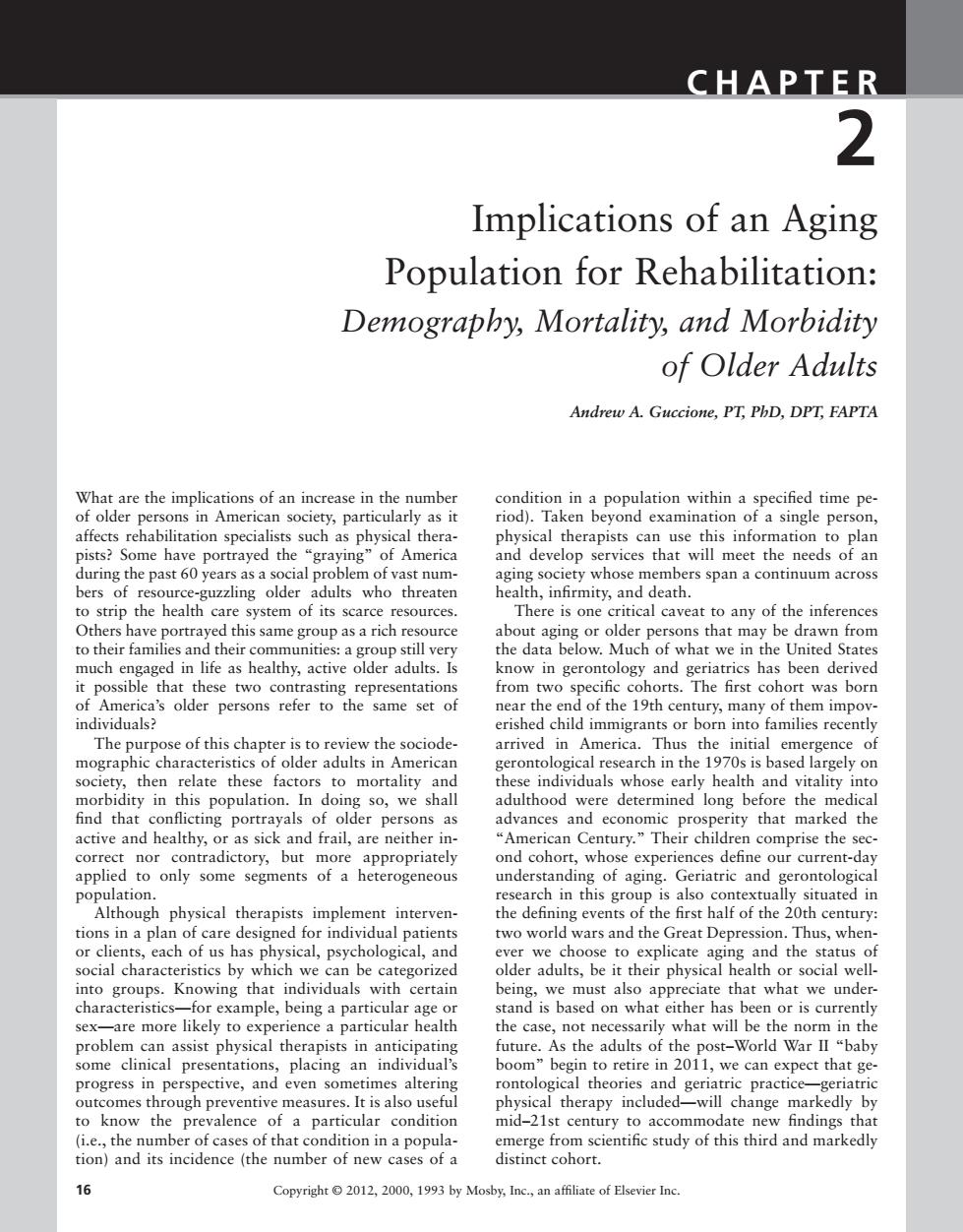正在加载图片...

CHAPTER 2 Implications of an Aging Population for Rehabilitation: Demography,Mortality,and Morbidity of Older Adults Andrew A.Guccione,PT,PhD,DPT,FAPTA or oler er oy d) en beyond phy during the past 60 years as a social problem of vast num- aging society whose members span a continuum across lth,infirmity,and death. h Thee of the n to their families and their communities:a g the data below Much of what wen th United States know in gerontology and geriatrics has been derived from two speci orts.The first coh ort was born h The purpose of this chapter is to review the sociode- arrived in America.Thus the initial m ence of mographic characteristics of older adults in American gerontological research in the 1970s is based largely on and vitality into ind that son is population of ol so,we determined ong be active and healthy,or as sick and frail,are neither in- correct nor contradictory,but more appropriately ond cohort,whose experiences define our current-day applied to only some segments of a heterogeneous rld wars and the Great Dep ion.Thus.whey or clients,each of us has ohysical,psychologi al.and we choose to explicate ag g and the status of n be ca older adults,be it their physical h ealth or social well- hto groups indi we mus o appreciate that wh at we unc are more likely to experience a p articular health the case necessarily what will be the norm in the future.As the adults of the post-World War II "baby boom begin to retire in 2011,we can expect that ge. progress in per pective, even some alter theories and geriatric to know the prevalence of a pnd-21st findings that (i.e.the number of cases of that condition in a popula- emerge from scientific study of this third and markedly tion)and its incidence(the number of new cases of a distinct cohort. 16 Copyright 2012.2000,1993 by Mosby,Inc.,an affiliate of Elsevier Inc16 What are the implications of an increase in the number of older persons in American society, particularly as it affects rehabilitation specialists such as physical therapists? Some have portrayed the “graying” of America during the past 60 years as a social problem of vast numbers of resource-guzzling older adults who threaten to strip the health care system of its scarce resources. Others have portrayed this same group as a rich resource to their families and their communities: a group still very much engaged in life as healthy, active older adults. Is it possible that these two contrasting representations of America’s older persons refer to the same set of individuals? The purpose of this chapter is to review the sociodemographic characteristics of older adults in American society, then relate these factors to mortality and morbidity in this population. In doing so, we shall find that conflicting portrayals of older persons as active and healthy, or as sick and frail, are neither incorrect nor contradictory, but more appropriately applied to only some segments of a heterogeneous population. Although physical therapists implement interventions in a plan of care designed for individual patients or clients, each of us has physical, psychological, and social characteristics by which we can be categorized into groups. Knowing that individuals with certain characteristics—for example, being a particular age or sex—are more likely to experience a particular health problem can assist physical therapists in anticipating some clinical presentations, placing an individual’s progress in perspective, and even sometimes altering outcomes through preventive measures. It is also useful to know the prevalence of a particular condition (i.e., the number of cases of that condition in a population) and its incidence (the number of new cases of a condition in a population within a specified time period). Taken beyond examination of a single person, physical therapists can use this information to plan and develop services that will meet the needs of an aging society whose members span a continuum across health, infirmity, and death. There is one critical caveat to any of the inferences about aging or older persons that may be drawn from the data below. Much of what we in the United States know in gerontology and geriatrics has been derived from two specific cohorts. The first cohort was born near the end of the 19th century, many of them impoverished child immigrants or born into families recently arrived in America. Thus the initial emergence of gerontological research in the 1970s is based largely on these individuals whose early health and vitality into adulthood were determined long before the medical advances and economic prosperity that marked the “American Century.” Their children comprise the second cohort, whose experiences define our current-day understanding of aging. Geriatric and gerontological research in this group is also contextually situated in the defining events of the first half of the 20th century: two world wars and the Great Depression. Thus, whenever we choose to explicate aging and the status of older adults, be it their physical health or social wellbeing, we must also appreciate that what we understand is based on what either has been or is currently the case, not necessarily what will be the norm in the future. As the adults of the post–World War II “baby boom” begin to retire in 2011, we can expect that gerontological theories and geriatric practice—geriatric physical therapy included—will change markedly by mid–21st century to accommodate new findings that emerge from scientific study of this third and markedly distinct cohort. C H A P T E R 2 Implications of an Aging Population for Rehabilitation: Demography, Mortality, and Morbidity of Older Adults Andrew A. Guccione, PT, PhD, DPT, FAPTA Copyright © 2012, 2000, 1993 by Mosby, Inc., an affiliate of Elsevier Inc